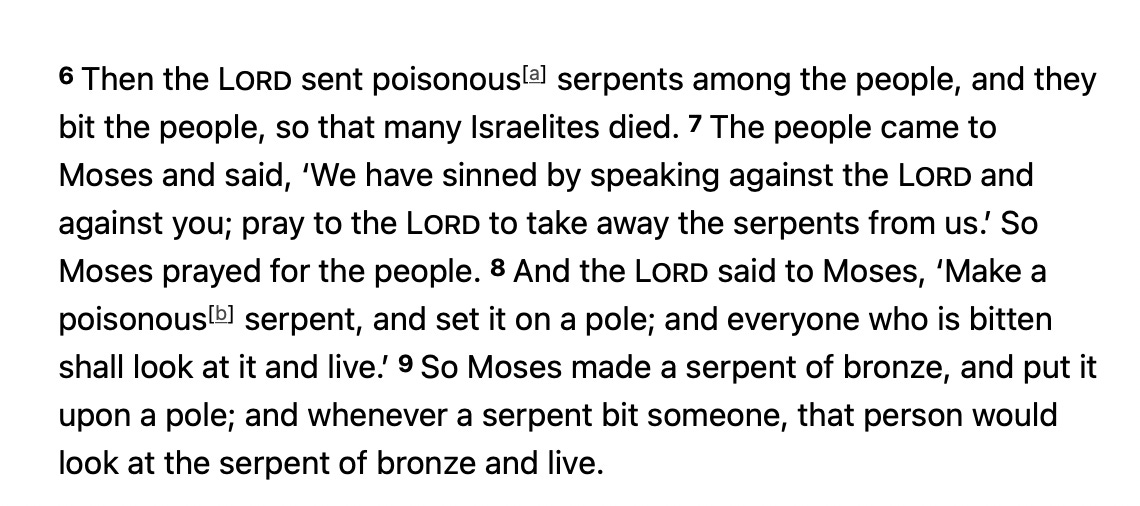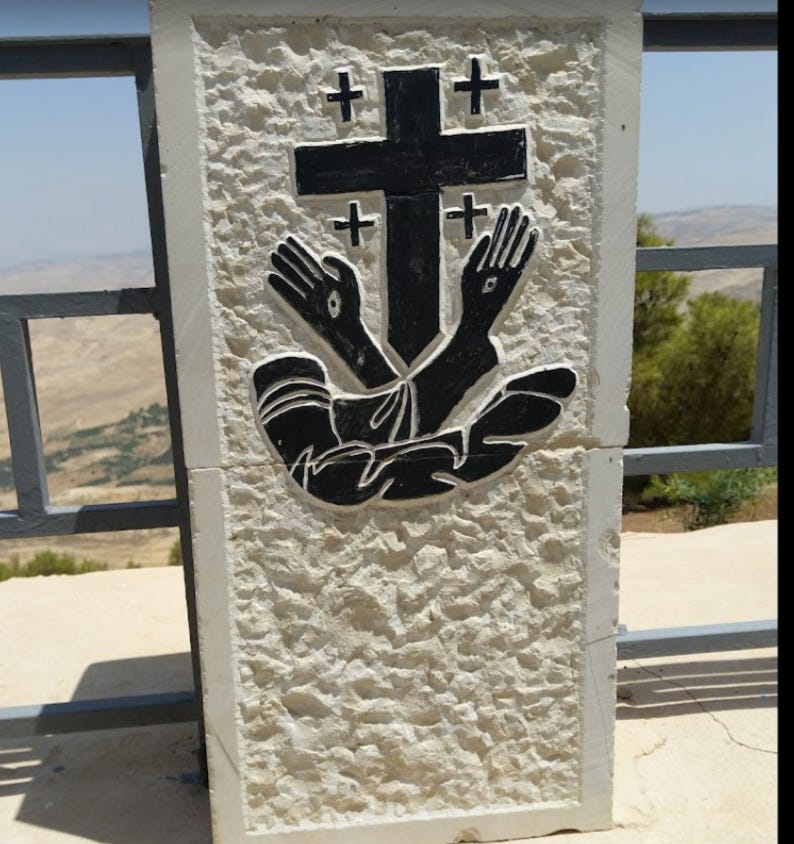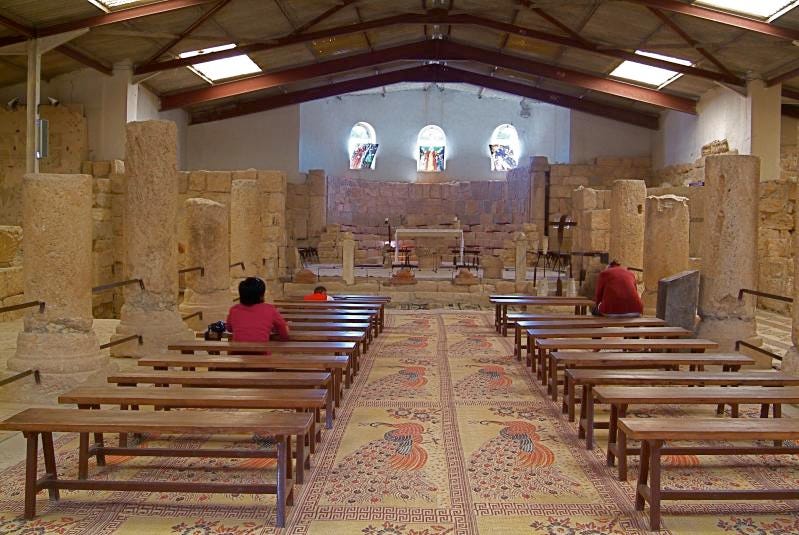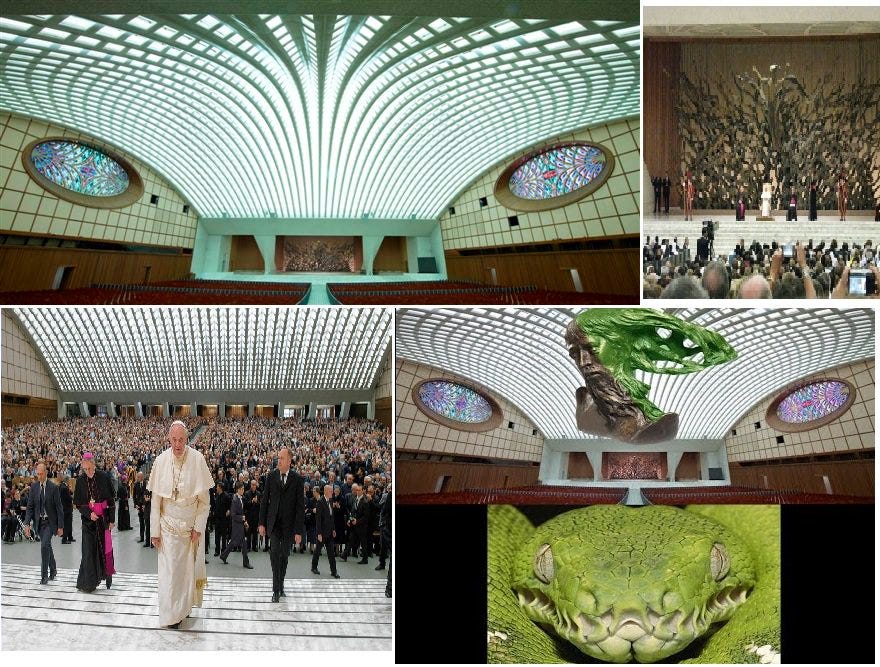Discover more from Pope Head Post
Something strange is occurring on Mt Nebo.
Mt Nebo of course being the mountain upon which Moses was granted a vision of the Promised Land before his death. Moses was not allowed to actually enter the promised land due to the incident at Meribah Kadesh. Towards the end of the Israelites 40 years in the wilderness, the people complained about a lack of water. God told Moses to speak to a rock, and that water would flow forth. Instead of doing what was asked, Moses struck the rock twice with his staff. God still allowed water to flow forth, but Moses and Aaron took the credit. For this disobedience, God forbid Moses and his descendants from entering the Promised Land. Moses would die and be buried somewhere on Mt Nebo.
An early Christian basilica was built on the site, memorializing the place in which the great prophet died. The church was abandoned in the 16th century, and only rediscovered in the 19th. In 1932, an order of Franciscans purchased the site, and began excavating in 1933. A memorial church was erected upon the site, still under the control of the Franciscans. As I started researching the church, compelled by reasons that will soon become clear, I was struck by the lack of information available on the internet. The church even lacks a wikipedia entry. This of course only encouraged my efforts.
The question is this. Why is there a giant sculpture of the bronze serpent erected on the site?
For those of you unfamiliar with the Nehushtan:
However by the time of 2 Kings, the Israelites had begun to worship the Brazen serpent as a god, and so King Hezekiah destroyed the statue to stamp out the idolatrous sentiment.
The Nehushtan is referenced again in the New Testament: “And just as Moses lifted up the serpent in the wilderness, so must the Son of Man be lifted up.” (John 3:14)
The implication is that Christ himself would be lifted up, alluding to his crucifixion, to heal the sins of the world, just as the serpent healed the Israelites. The verse is not conflating Christ with the bronze serpent, it is merely referencing the act of lifting and healing that the serpent accomplished, in the same manner that Christ would.
And so in Christian art we occasionally see this motif being portrayed, the serpent being lifted by Moses, typologically alluding to the crucifixion.
But it is never just the serpent. Moses is always accompanied, as it is the act of lifting the serpent that alludes to Christ. The serpent on its own would simply allude to the idolatrous veneration of it that King Hezekiah had to put an end too. So the question becomes, why did the Franciscans erect this monstrosity?
A recreation of the idol that God had destroyed. No where in Christian art has an idol of the Nehushtan been recreated in this way. Stripped of the context of the raising, it is simply a grotesque fetish object, a restoration of what God had ordered destroyed. It would be one thing if this was the site in which the bronze serpent had been originally erected (and even then in poor taste) but Mt Nebo has absolutely no associations with the bronze serpent. If they were trying to commemorate Moses, why not erect a statue of the Decalogue tablets, or a statue of the Prophet himself? It makes zero sense from a Christian standpoint, and amount to nothing more than a monument to idolatry. I tried to research the artist and the circumstances behind its erection, but was lead down even more bizarre paths, which we will analyze later.
While Mt Nebo is not associated with the raising of the serpent, it is geographically associated with a different serpent. Upon this realization, my research took a darker turn.
As stated earlier, Moses’ death is associated with Mt Nebo, and he was likely buried around the area. What happens after Moses’ death?
“Yet Michael the archangel, when contending with the devil he disputed about the body of Moses, durst not bring against him a railing accusation, but said, The Lord rebuke thee.” (Jude 9).
The Archangel Michael arguing with Lucifer over the body of Moses.
For what possible reason, would a massive bronze serpent be erected by Franciscans, on a site already associated with satan?
Maybe if this was the only questionable element of the church complex, I could overlook it as questionable judgement and poor taste by good intentioned friars. But it gets worse, much much worse.
Let’s take a look at the altar of the church.
Why, in the name of GOD, have they inscribed this depiction onto the focal point of the altar? Where is Jesus? What is going on here! The only crucifix is off center, and facing away from the audience. This is the only depiction of Christ in the church.
In every picture I found it was the same!
Now let’s bring our attention to the stained glass.
To the untrained eye this may look innocuous. Until you realize what it’s portraying. That is Michael and Lucifer fighting over the body of Moses. Michael and Lucifer are portrayed so identically that you are not sure which is which! Both noble beings of light, identical color schemes! I can find no precedent for this in ecclesiastic art! When the two beings fight, they are always contrasted! Michael shines noble while Lucifer is depicted hideously! The only instances of Lucifer depicted beautifully is when he’s on his own, as a kind of haunting reminder that he was once the most beautiful of angels. Never when he is in the presence of other angels!
What is going on!
Here is the next stained glass piece:
Moses and Aaron, striking the rock, disobeying Gods command, that which would damn him to not going further then Mt Nebo! The light comes down, and is refracted by the staff into an infernal and ethereal turquoise glow, forming a triangle and an eye.
I wonder, is that Aaron, or Lucifer whispering in his ear? He is cast in the same light as the eye.
And then finally, the center piece.
The serpent, reigning from the sky, illuminating the world in his glow.
Where is Christ? Who is this Church dedicated too?
There is a plethora of weird art on display in the Franciscan complex.
Why is the Franciscan symbol have stigmata that appear to be eyes? I have never seen the Franciscan logo fashioned in such a way. The stigmata never resembles this. For a normal depiction, see the image below.
hmmm….
Very strange indeed.
The Rosy Cross? hmmmm
Broken columns and peacocks, ill let you mull over the implications for yourself.
Now, who is the artist of the brazen serpent? It is supposedly an Italian by the name of Giovanni Fantoni. But I can find absolutely nothing online about him other then he is listed as creator of the monument. The man is a ghost.
However, there is one Giovanni Fantoni that I do know of. An 18th century poet and political radical. English sources are scant, and if you can’t read Italian then you would find next to nothing. Fantoni was a staunch anti clerical Jacobin, and participated in numerous revolutionary movements. He was also associated with a myriad of secret societies. We know he was a freemason in the Napolitan lodge La Vittoria. He was a member of La società dei Raggi, a clandestine organization created by Count Alessandro Savioli-Corbelli, a high ranking member of the Bavarian Illuminati, who fled from Germany to Italy after the crack down. The Ray Society would reorganize and form into La Società dei Centri, another ultra secretive group that blended revolutionary activity with occult initiation. The society was very similar to the Carbonari, and the two groups would eventually merge. Anyone who wants to understand the full implications of that must read my article on the Charcoal Burners. The purpose of these clandestine early 19th century secret societies was revolutionary activity and the destruction of organized religion.
The lack of available information on Fantoni and his societies may be intentional. As a figure he may still be held in high esteem in current clandestine societies, and his name well known. Could the naming of the artist as Fantoni be a subtle wink and a nod? A tip off to all initiates that the Brazen Serpent in Nebos is a representation of something darker? This is a common tactic in clandestine societies. An example being the hanging of Calvi on the Black Friar bridge, letting everyone know that it was P2 who got him.
You may be skeptical to all of this, rationalizing ways in which the imagery can be neatly contextualized. But let me ask you, why employ serpent imagery at all? All it does is engender more conspiracy and paranoia, strengthening the Protestant claims that the Vatican is the seat of satan. Why commission work like this?
A serpent head peering into the garden of Campo Santo? Named after the pope that dissenters claim to be evil?
Why erect a bronze serpent that can easily be construed? The Catholic Church should be combatting error, not inviting it! Again, why didn’t they erect a statue of Moses, or a monument of the Decalogue, or a burning bush, anything related to Moses that was not a serpent, in a site already related to an incident with the Devil?
___________
To understand why all of these elements have a coherent and underlying logic to them, why this to me comes as no surprise, one must understand the Renaissance appropriation of Moses as Hermetic magician. An appropriation propagated by a handful of Popes, almost all of them Franciscans. In fact, one covertly erected several bronze serpents, that thousands of Romans pass by daily. Their meaning obfuscated by the veneer of Catholic piety. I have been working on this for a while, and I believe I am the first to my knowledge to put the Franciscan connection together. You will have to wait for my article on Moses the Magician.
I ask you this, help me find more information on the statue and the complex as a whole, because I am having difficulty. Perhaps this is all one big coincidence. Engendered by poor taste and poor theology. But when there are too many coincidences, there are no coincidences.
UPDATE
Is it not interesting that the sculptor decided to go with a tau instead of a Christian cross or normal pole (as its listed in scripture) for the snake? To at least make it a little more Christian? Something like this:
Let me just leave you a quick quote from Eliphas Levi
Subscribe to Pope Head Post
Papal history and deep topography.








































Sorry for being painfully new, but what do the columns and peacocks symbolise? Nice article